
The documentary “16 Shots” examines the 2014 murder of African-American teenager Laquan McDonald in Chicago and the attempt by the city’s police department to cover up the events. McDonald, who was 17, was shot 16 times by former police officer Jason Van Dyke. Van Dyke was found guilty in 2018 of second-degree murder and sentenced to six years and nine months in prison for McDonald’s murder. He was also found guilty on 16 counts of aggravated battery—one count for each of the 16 bullets he fired at McDonald. The film is screening on Showtime. We speak with Rick Rowley, director of “16 Shots.”
Transcript
AMY GOODMAN: This is Democracy Now! I’m Amy Goodman, as we turn to a remarkable new documentary that just premiered on Showtime. The film is called 16 Shots. It examines the 2014 murder of African-American teenager Laquan McDonald in Chicago. This is the trailer.
UNIDENTIFIED: Chicago Police Department averages maybe 30 police shootings a year.
WILLIAM CALLOWAY: I think it’s a level of people being desensitized from the violence.
JEFFREY NESLUND: When you look at the police reports that were signed off, it’s a justified shooting.
GARRY McCARTHY: If somebody gets near you with an open knife, I’m sorry, but that’s a threat.
PASTOR MARVIN HUNTER: What the local news put out there—
PAT CAMDEN: An individual with a knife coming at the officer.
PASTOR MARVIN HUNTER: —that is not the story. This boy been shot, and it’s a lot of bullet holes in him.
JAMIE KALVEN: There is police dash cam video that contradicts the official story.
JEFFREY NESLUND: What we saw was, in our opinion, first-degree murder.
CHARLENE CARRUTHERS: There is an escalation of involvement from people across the city.
PASTOR MARVIN HUNTER: Justice for us is Jason Van Dyke being convicted of the murder of Laquan McDonald.
WILLIAM CALLOWAY: He was their son. He was their brother. He was them.
KIM FOXX: Chicago has not had to reckon with what happens when you don’t hold folks in law enforcement accountable.
JAMIE KALVEN: Almost overnight, the power and legitimacy of city institutions cratered.
UNIDENTIFIED: There’s 86 minutes that are missing.
GARRY McCARTHY: The Laquan case was not a cover-up.
PROTESTERS: Sixteen shots!
JAMIE KALVEN: It’s a story of our racial nightmare in this country.
PROTESTERS: Sixteen shots!
PROTESTER: If he is acquitted?
PROTESTERS: Shut it down!
AMY GOODMAN: The trailer to 16 Shots, the new documentary on Showtime. Former Chicago police officer Jason Van Dyke was found guilty in 2018 of second-degree murder, sentenced to six years and nine months in prison for McDonald’s murder. Van Dyke was also found guilty on 16 counts of aggravated battery—one count for each of the 16 bullets he fired at McDonald.
Well, Democracy Now! recently spoke with Rick Rowley, director of 16 Shots. I began by asking him to lay out how this film chronicles this case, beginning with the day Laquan McDonald was murdered.
RICK ROWLEY: We show the moment that every single actor along this process kind of steps in, from the beat cops who initially respond. The first thing they do is they erase—it seems very clear, they destroy evidence. They erase this surveillance video that’s from a Burger King that’s across the street. Eighty minutes are just erased off the machine. They shoo away witnesses. They take some civilian witnesses back to City Hall. And those witnesses described to us—you know, for the first time on camera, in this film, they described being threatened by officers and being coerced into trying to say that they didn’t see what they saw.
Then, you know, immediately what happens is the spokesman for the Fraternal Order of Police, the police union in Chicago, comes out, and he creates the first version of this story. And that’s the story that goes out to the press everywhere. You know, and that is almost always the first and last story. I mean, there are 30 to 60 police shootings a year in Chicago, every week or every other week. You know, in the course of my lifetime, that’s thousands of people who have been shot. And the cases all end in the same way: a small like note in the end of the press, and then we turn the page.
AMY GOODMAN: I want to go back to Burger King—
RICK ROWLEY: Yeah.
AMY GOODMAN: —where the police come into the Burger King, that has closed-circuit TV. They don’t have a warrant. What do they do?
RICK ROWLEY: They demand access to the surveillance system. They don’t have a warrant. They don’t have any legal rights to go in and seize the equipment, but they do anyway. They get the night manager to give them the password in there. We can see them on the surveillance footage, you know, messing around with the computer system. And the next day, 87 minutes, from all of the cameras, is just missing. And we know—you know, we actually did a bunch of research. We contacted the engineers who install these systems. And this just doesn’t ever happen. Not only is it missing, but there’s multiple redundant backups on that machine that are all also missing. So, you know, it seems evident that the officers on the scene there erased that footage and just made it disappear.
AMY GOODMAN: Rick, there were witnesses, nonpolice witnesses, at this late-night killing. These are the witnesses, in your film, to the shooting: Alma Benitez, but first, Xavier and José Torres.
JOSÉ TORRES: I don’t want to talk bad about all police officers, because they’re not all bad. I have a lot of friends that are police officers. But, you know, after seeing this, I lost pretty much the trust in the police. We were traveling northbound on Pulaski. I was actually the first car that pulled up at the scene.
ALMA BENITEZ: I had just barely come off from work. I was headed to Burger King. I see a guy running next on my window. He was getting chased by the cops. They were chasing him.
XAVIER TORRES: We had the streetlights. We were able to, you know, get a good view of what was going on. There were a lot of police officers. And it just seemed like he was just trying to get away from what was going on.
JOSÉ TORRES: The first shots came in, and he dropped.
ALMA BENITEZ: Shots, and saw him drop. He literally dropped.
JOSÉ TORRES: And there was a small pulse. I see Laquan McDonald move. It didn’t seem like he was getting up; it just seemed like he was in pain. But that’s when all the shots started coming in.
XAVIER TORRES: He was on the ground, and still more shots came in.
ALMA BENITEZ: While the gunshots were going in, his just body kept jumping. You could tell it was—he didn’t have no life in there no more. And next thing I remember is yelling, “Stop shooting! He’s dead already!”
JOSÉ TORRES: I was kind of upset. And I said, “Why the [bleep] are they still shooting him? He’s on the ground.”
XAVIER TORRES: From what we’ve seen, he wasn’t posing any type of threat.
ALMA BENITEZ: The detectives call me over. And they took us to the precinct. They separated us in three different rooms.
JOSÉ TORRES: They brought me to a small office, and they started questioning me and asking me what happened.
ALMA BENITEZ: I talked to several detectives, not one. And they kept asking me the same questions over and over again: What did you see? How many gunshots did you hear? The more I kept telling them of what I saw, they were trying to make me—they were telling me stuff like, “Well, we’re watching the video, and your story does not match.” And I said, “Well, if it doesn’t match, then—and you have a video, what am I doing here?” And they said, “Well, you know, it’s not good to lie.” They really wanted me to change the story about how many shots I had heard. If I didn’t tell them what they wanted to hear, I definitely thought I was going to go to jail.
AMY GOODMAN: That’s Alma Benitez, talking about what she saw, and José and Xavier Torres before her. Now, compare these eyewitness reports to the spokesperson and the head of the Fraternal Order of Police.
RICK ROWLEY: Yeah, clearly, I mean, Pat Camden arrives on the scene, and he immediately packages for the press the official police response, which is that this was a violent offender who was waving a knife in a menacing way and had to be shot. You know, the stunning thing is that even after the video is released, even after Pat Camden, Dean Angelo—who’s the spokesman for the FOP; Dean Angelo, the former head of the FOP at the time; and Garry McCarthy, the police chief—even after they saw the video, they were able—they looked at it and said that this looks like a justified shooting.
AMY GOODMAN: But Van Dyke was not the first officer on the scene.
RICK ROWLEY: Yeah. One of the interesting, sort of poignant parts of this story is that the first responding officers, they’re responding to a 911 call saying that there’s a kid who might be breaking into trucks in a truck yard. They show up. It’s Officer Gaffney and Officer McElligott. And they do everything kind of by the book, as you would expect law enforcement officers to deal with it. They don’t provoke McDonald. They see he has a knife. They follow behind him, 10 paces back, with their lights on, and they call in and ask for a Taser, for the only kind of nonlethal enforcement they have. They follow him for a significant amount of time. More and more officers are arriving. The Taser is on its way. And then, suddenly, Van Dyke’s car pulls up. He jumps out of his car. And in under six seconds, he’s unloading his clip into Laquan McDonald.
And so, these officers have now just witnessed an atrocity. And they go, and they all have to make their statements. So, the statements from—there are nine other officers on the scene. Most of the statements say that—you know, tell a completely unfactual account of what happened, that Laquan was waving the knife, advancing on Officer Van Dyke, which obviously is just a lie. Several of the officers say, “I didn’t see anything.” The officer who’s driving the car that has the dash cam in it claims that they didn’t see anything happen.
So, that was, you know, the greatest act of resistance probably that was imaginable for an officer at that time, knowing that even if you tell the truth, nothing is going to happen to this officer, because nothing ever has in the 180-year history of the Chicago Police Department, and that the only outcome is going to be that you’re going to end your career, potentially, and put yourself in danger. So, anyway, all of the officers’ statements kind of corroborate this completely untrue story that Laquan was the aggressor.
AMY GOODMAN: Let’s go to the clip. It begins with the FOP spokesperson—mind you, none of these guys are in power, in office, right now—Pat Camden, and then to the head of the Fraternal Order of Police, also not there, and, ultimately, the police chief, Garry McCarthy, was fired, as well.
PAT CAMDEN: As you look at something frame by frame, again, without the emotions that are involved, you can draw a conclusion. My conclusion was, you know, the officer did what he had to do to protect himself.
DEAN ANGELO: I see a situation that is gotten away. I don’t know where everybody’s head is at in that situation.
GARRY McCARTHY: There’s a knife. I’m sorry, but that’s a threat. If somebody gets near you, within 21 feet of you, with an open knife, you could die.
PASTOR MARVIN HUNTER: As you saw and I’ve seen, Laquan McDonald was murdered. This family wants justice to be served. And justice for us is Jason Van Dyke being convicted of the murder of Laquan McDonald.
AMY GOODMAN: Which of these people is not like the other? Which of these people just doesn’t belong? And that’s Pastor Marvin Hunter at the end, the granduncle of Laquan McDonald.
RICK ROWLEY: Yeah. It is one of the—one of the remarkable things is that in spite of all the facts that we have about this case, in spite of the video, in spite of all of the evidence that’s come forward, those facts are not enough to secure the narrative. Even in the face of those facts, there is another story, a competing story, that is very powerful in this country and that’s built on racial fear. And that is what was being mobilized on the other side of this sort of discourse.
So you see that unfold in the trial. The defense invokes it constantly. There are these amazing moments where Dan Herbert, the defense attorney for Officer Van Dyke, talks about this as a “horror film.” He says, “Imagine you’re watching a horror film, and the monster suddenly turns and looks at you, and then the music starts to play. That’s what happened here.” So, he’s casting Laquan McDonald as a monster.
Dean Angelo says—you know, the former head of the FOP—says to Jacquie Soohen, the producer and interviewer, “You know, people need to recognize, no one is accepting the fact that what we need to do is go after that monster, who doesn’t belong in the street with you or my wife or my daughter”—basically, with white women, like invoking the oldest nightmare, American racial nightmare, there is.
AMY GOODMAN: So, October 20th, 2014, is the day Laquan McDonald is gunned down by Jason Van Dyke. Again, Van Dyke then controls the narrative, or the FOP does, by saying that he felt his life was threatened. No one saw otherwise, so this was just par for the course. Talk about then how this case developed, how it changed from that night.
RICK ROWLEY: Yeah. So, that would have been the end of it, ordinarily, in any one of these thousands of other cases where this has happened. But two things happened that weren’t expected. First, a whistleblower in law enforcement got in touch with investigative journalist Jamie Kalven and told him, “There’s a video out there. There’s a video, and it’s horrific.” And he was worried that it might be destroyed if no one started asking for it.
The other parallel thing that happened was the family began to ask questions. So, Pastor Marvin Hunter, the great-uncle of Laquan McDonald, he—when Laquan’s body was delivered to the funeral home, the funeral home called him up and told him, “You know, in the news, they were saying he was shot once in the chest, but he’s full of bullet holes.” So they took pictures, and they took those to an attorney, and they began the process of exploring civil litigation around the case, which ended up opening a separate kind of line of inquiry that helped rip the case open.
AMY GOODMAN: Rick Rowley, director of the new documentary 16 Shots. We’ll be back with him in 30 seconds.
[break]
AMY GOODMAN: “Change” by Mavis Staples. This is Democracy Now! I’m Amy Goodman, as we continue our discussion with Rick Rowley, director of 16 Shots. It just premiered on Showtime.
AMY GOODMAN: This isn’t about just public officials changing their minds or video coming out from an insider in the police department. This is about people on the ground who couldn’t take it anymore. Explain how that movement built. Who is Will Calloway?
RICK ROWLEY: Yeah, absolutely. No, that’s definitely true, that one of the essential processes through this is that everyone inside the system is playing by the rules of a game that’s existed for over a hundred years. And they know that they’re going to win, because they’ve always won. But what they don’t realize is that outside, in the street and in culture, the rules of that whole game are changing. They live in a different world by the end of this case than they did at the beginning. And they live in a different world because there’s a social movement out there that changed that world. And Charlene Carruthers, the former head of BYP100, and Will Calloway, an activist who became involved with this case from the very beginning, are responsible in a large way for those changes that happened.
So, Will was an activist working on police issues, on the Rekia Boyd shooting, which happened in Chicago a year earlier. When he read Jamie Kalven’s piece that revealed that there was a video out there, he FOIAed for the video, along with a bunch of other media outlets. Like a couple dozen media outlets FOIAed for the video. All the FOIAs were denied—ongoing investigation. You know, it’s a typical logic that is deployed whenever people want to keep things hidden. No one—everyone else dropped it. Will didn’t drop it. He sued the city. Everyone—you know, he sued the city, and he won. It was another unprecedented moment for transparency in the city.
AMY GOODMAN: And so, talk about what happened next. The judge ruled it would have to be released within a few days.
RICK ROWLEY: Yeah. So, suddenly, the city realizes that this entire machine, that they had had faith in would continue to function, had fallen apart. It had just exploded. And so, the state’s attorney, Anita Alvarez, immediately brings murder charges against Officer Van Dyke—this is the first time an officer has ever been charged for murdering a black citizen—a day before the video is released.
Then the video is released, and it sends shockwaves through the city, because this video is—you know, there are a lot of videos of these shootings that are circulating now. Most of them are, you know, shaky cellphone videos, partial recordings—the recording begins partway through the encounter. This video is unparalleled in its clarity. It’s a locked-off shot from the dash cam of a police car, and you see every second of Officer Van Dyke’s interactions with Laquan McDonald. You see his car pull up, him jump out of it and begin to fire. There isn’t a second before the video starts; you see everything. And because it’s happening on a street with the lane lines painted, it might as well have been taking place on graph paper. You can see that Laquan is moving away. You can see that he’s no threat. It has—and you can see his body lying on the ground while Van Dyke continues to shoot into him. It’s unprecedented in its clarity and in the horror you see in it.
AMY GOODMAN: All of this is playing out, before the video is released, in the mayoral re-election of Rahm Emanuel. And explain what happened exactly when the video dropped in the process of his campaign, and also a settlement the family made that people did not know about for quite some time.
RICK ROWLEY: Yeah. So, the city—we know from internal email and communications that have been—you know, that journalists sued for and have been released, that the city was obsessed with this case. All of Mayor Rahm Emanuel’s senior staff were discussing it. They were circulating stories about it. They were talking about the video. But there was no lawsuit filed about it yet.
So, Rahm Emanuel is in a very tight runoff with—and he didn’t win a majority, an outright majority, in the first election. It’s in a runoff. It’s very close. It looks like he might lose. And this video could be released at any moment by the family, if they decide to bring charges. So, the lawyer for the city—the Mayor’s Office sends their lawyer to make a $5 million settlement with Laquan McDonald’s family—before any charges have been filed. There’s no lawsuit. It’s a preemptive settlement, $5 million to delay the release of the video ’til after the election is over.
AMY GOODMAN: So, Anita Alvarez, you and Jacquie Soohen interview several times, the state’s attorney, who does not bring charges against Jason Van Dyke, even though she clearly has seen this video. What did she have to gain by not bringing charges?
RICK ROWLEY: Well, it was great, because when heads really started to roll around this case and the institutions inside the city split, turned against each other, people began briefing against each other. And so we were able to get much more candid interviews from everyone around. It’s a great moment to be a documentary filmmaker when that happens.
But we interviewed Anita Alvarez while she was still state’s attorney. And she makes it very clear. She admits that she saw the video right away, but she says, “It’s very hard to prosecute police officers. And, you know, we didn’t—we thought we would lose.” But once the video is about ready to be—is going to be released, and they know it’s going to be released, she’s worried about civil unrest in the city. She’s worried there will be riots. So she charges Van Dyke with murder the day before the video is released, to try to preempt the anger that everyone knows is going to roll out into the street.
AMY GOODMAN: So, Rick Rowley, set up this next clip.
RICK ROWLEY: So, charges have been brought against Van Dyke the day before this video is released. The whole city is expecting—doesn’t know what to expect, expects civil unrest. The police are on high alert. People are talking about riots. And the movement—well, the whole city clusters around their phones and their computers to watch the video the moment it is released. And when they see it, it is shocking, it is graphic, it is horrific. And the protesters pour out into the streets on Black Friday, the busiest shopping day of the year. And they shut down the—
AMY GOODMAN: The day after Thanksgiving.
RICK ROWLEY: The day after Thanksgiving. And they shut down the Magnificent Mile in downtown Chicago.
AMY GOODMAN: This clip begins with Charlene Carruthers.
CHARLENE CARRUTHERS: He was shot 16 times—1, 2, 3, 4, 5, 6, 7, 8, 9, 10, 11, 12, 13, 14, 15, 16. He was shot 16 times.
PROTESTERS: Sixteen shots! Shut it down! Sixteen shots! Shut it down! Sixteen shots! Shut it down!
WILLIAM CALLOWAY: They saw him. He was their son. He was their brother. He was them.
PROTESTERS: Sixteen shots! Sixteen shots!
WILLIAM CALLOWAY: Know how many times I ran from the police, growing up in the city? How many times I was put in a position where Chicago police pull guns on me? So, when I saw Laquan, I saw me.
AMY GOODMAN: Will Calloway. “So, when I saw Laquan, I saw me.”
RICK ROWLEY: Yeah, that’s a sentiment that was felt throughout the kind of movement out there. Will has described it, at different times, as a kind of divine justice or divine poetry, that Laquan McDonald, a figure who was so marginalized in the city that he was practically invisible up until the moment of his death, ended up taking down the most powerful people in the city of Chicago.
AMY GOODMAN: So the trial takes place September of 2018. Describe the moment of the verdict.
RICK ROWLEY: The trial has been this amazing kind of public spectacle in Chicago, the focal point of the city’s attention for the weeks that it happens. And as the jury is—as the case is given to the jury and they go in to deliberate, the city is on the edge of its seat. I mean, the people, again, are fearing riots if there’s an acquittal.
When everyone is called back, because there’s—a verdict is ready, I’m filming in front of City Hall, because 100 or 200 activists have gathered in front of City Hall, and their plan is—they’re certain it’s going to be a “not guilty” verdict. It’s unimaginable that a police officer will be found guilty of murdering a black citizen. And so their plan is to go inside City Hall and shut it down—shut it down, if it comes back “not guilty,” and be arrested. So we’re standing outside. The whole group is leaning into their cellphones, playing the video over megaphones—or, the audio over megaphones. It is this incredible moment.
And as the verdict is read, first, guilty of second-degree murder, and then the 16 counts, one for every shot—shot one, guilty; shot two, guilty; shot three, guilty—as those shots are being read out, people are weeping. They’re in tears. Something unimaginable has happened to them. It’s like a tear has opened in the fabric of political reality, and something else is visible on the other side of it. I have seldom seen moments of that kind of intense public intimacy. And I was incredibly grateful to be able to be there and see it. But there was a feeling amongst everyone there that a page had been turned and that something—we were in a new moment, a new moment that we were going to all have to find out what it meant.
AMY GOODMAN: Ultimately, though, while he was found guilty of each of those 16 shots, while Jason Van Dyke was found guilty of second-degree murder, his sentence?
RICK ROWLEY: So, months later, in January of this year, two things happened, days apart. First, there was a conspiracy trial for the other officers on the scene, where they were charged with conspiring to cover up this murder. All of them were acquitted. The next day, Van Dyke was sentenced, and the judge, Judge Gaughan, decided not to consider the 16 counts of aggravated battery, one for each shot, only consider the second-degree murder, and gave him six-and-a-half years, eligible for release in three years.
And, you know, we talked to the jurors, who felt betrayed. I mean, they went in there—so, each count of aggravated battery carries 6 to 30 years per count. They thought that they were giving a verdict that was going to mean Van Dyke was going to jail for the rest of his life. And instead, it was shortened to, you know, less time than—I mean, there are hundreds of people in Cook County Jail right now awaiting trial for more than three years because they can’t afford the 500 bucks it would take to make bail.
AMY GOODMAN: And so, what do you think is the lesson today, as the activists continue in the streets of Chicago, and what this means for the country, as Showtime broadcasts your documentary?
RICK ROWLEY: I mean, there’s two things that cut through this for me. The first is, you know, the scale, the massive scale of the cover-up. I mean, this is not a scandal. This is not aberrant behavior. This isn’t three people in a room deciding that they’re going to clear this one bad officer. This is every institution in the city being complicit in this in some way or another, in small or large ways.
The other lesson is that for all of the strengths of this machine, it broke down. That wall of silence was shattered in this case. And it was shattered because dozens of people, at crucial moments, came forward and took brave stands and broke it, and also because of the sustained attention and pressure of movements. I mean, this is a story arc that’s four years long. People stayed on this. They stayed in the street. They stayed active, and they kept pushing this. And so, that—I’m in awe of the people of Chicago and of the journalists and the social movements there who maintained the pressure throughout and managed to win victories that have been elusive in every other city in this country.
AMY GOODMAN: Rick Rowley, director of the new documentary 16 Shots. It just premiered and is available on Showtime. Rick was nominated for an Academy Award for the film Dirty Wars.
And that does it for our show. Congratulations to Democracy Now!’s general manager, Julie Crosby, and her partner, Rebecca Wallach, on the birth of their baby, Ryan Joseph Crosby-Wallach. Welcome to the world.


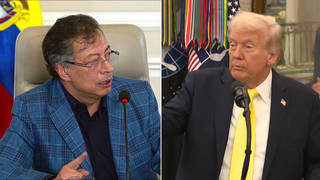
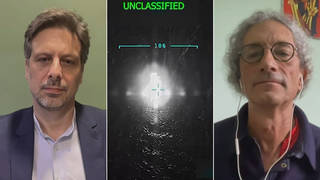
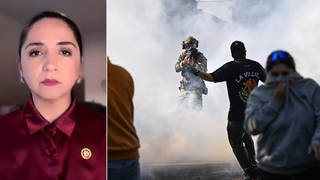





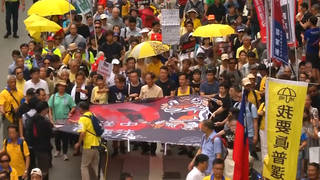
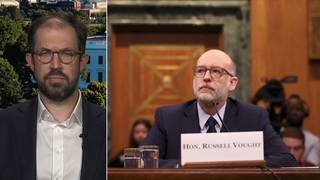
Media Options